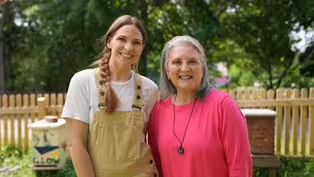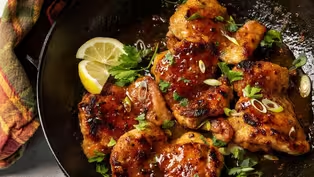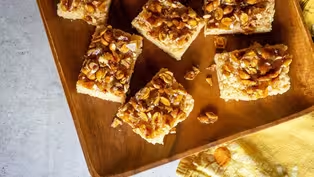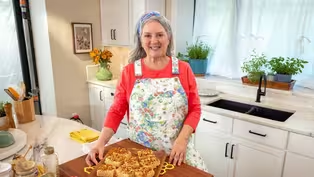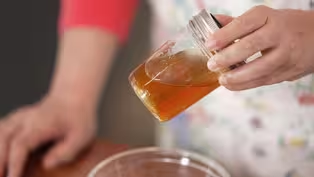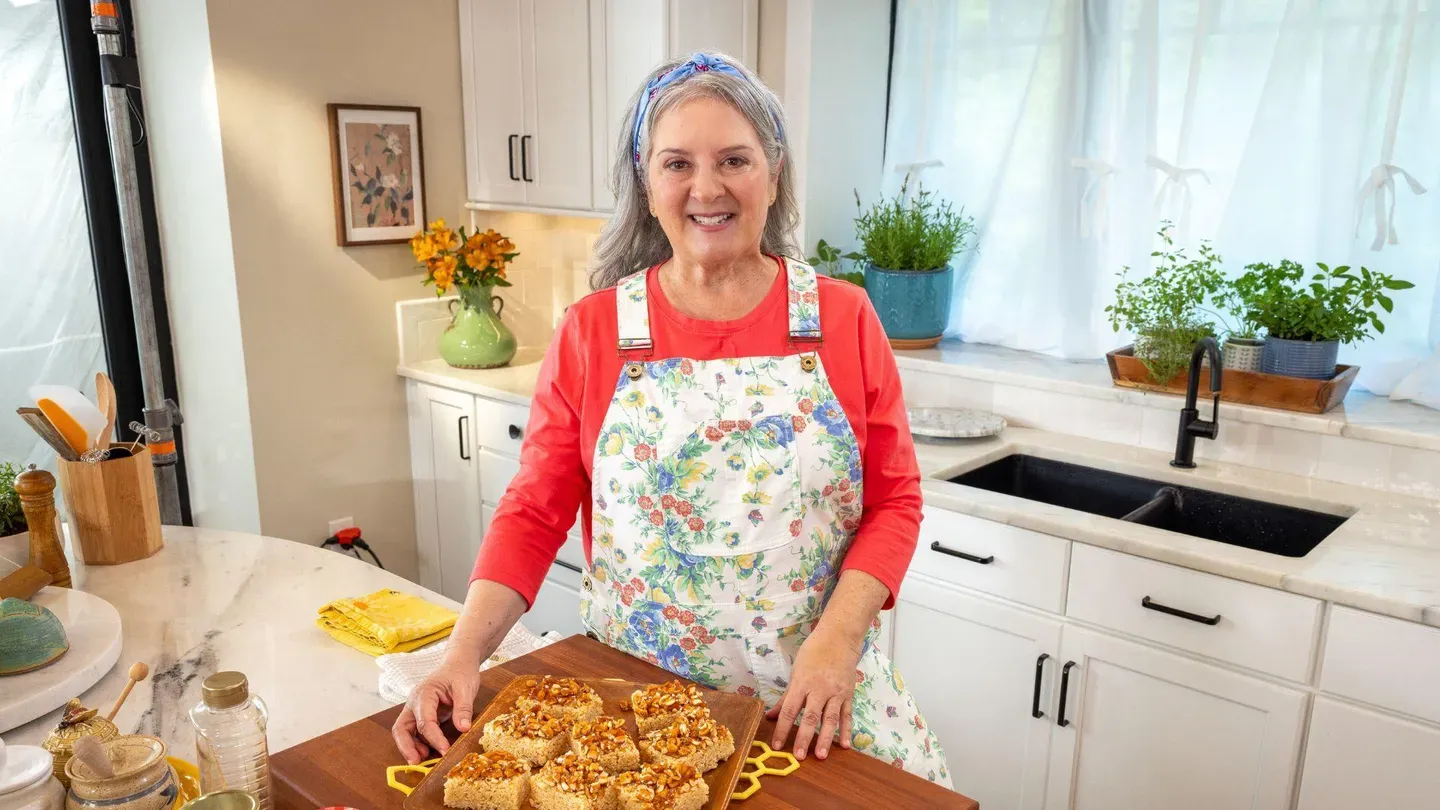

Hey, Honey
10/1/2024 | 26m 46sVideo has Closed Captions
Sheri Castle explores honey, a sublime ingredient that expresses the unique taste of “right here.”
Host Sheri Castle is busy as a bee as she prepares honey-roasted peanut crispy rice treats and honey-glazed chicken thighs, plus offers a tip on reviving the crystallized honey in your pantry. She dons a bee suit with beekeeper Mary Garrison to learn why pollinators are so vital, and then makes a spiced honey cake pie with award-winning baker Camille Cogswell.
Problems playing video? | Closed Captioning Feedback
Problems playing video? | Closed Captioning Feedback
The Key Ingredient is presented by your local public television station.

Hey, Honey
10/1/2024 | 26m 46sVideo has Closed Captions
Host Sheri Castle is busy as a bee as she prepares honey-roasted peanut crispy rice treats and honey-glazed chicken thighs, plus offers a tip on reviving the crystallized honey in your pantry. She dons a bee suit with beekeeper Mary Garrison to learn why pollinators are so vital, and then makes a spiced honey cake pie with award-winning baker Camille Cogswell.
Problems playing video? | Closed Captioning Feedback
How to Watch The Key Ingredient
The Key Ingredient is available to stream on pbs.org and the free PBS App, available on iPhone, Apple TV, Android TV, Android smartphones, Amazon Fire TV, Amazon Fire Tablet, Roku, Samsung Smart TV, and Vizio.
Providing Support for PBS.org
Learn Moreabout PBS online sponsorship- [Announcer] This program was funded in part by The Forest at Duke, a retirement community in the heart of Durham, North Carolina.
With more than 350 residents, The Forest at Duke presents residents with ongoing opportunities to keep growing.
[light upbeat music] - [Sheri] Coming up on "The Key Ingredient."
From the beehives to my kitchen counter, it's all about honey.
We'll explore ways to use honey in all sorts of things, from tempting, crispy rice treats.
Friends, how cute are these?
To a sweet and savory chicken supper.
And for dessert, we'll cook along with baker Camille Cogswell, who prepares a honey-kissed pie.
- I have always loved to eat pie.
- That's next.
I'm Sheri Castle.
I write cookbooks, I write for food magazines, I cook, I teach, and I collect stories.
And my favorite stories are the ones behind our best loved home recipes.
That smells good.
You think bears are gonna come?
- Probably out here.
- [Sheri] Oh, that's awesome.
I will go out and explore from the ground up the best ingredients that go into some of our most beloved family recipes.
It's all about the food, the flavors, and finding the key ingredient.
[light upbeat music] Mary Garrison is a honeybee keeper who wants us to understand and treasure the vital role that bees play in nature, gardening, and farming.
Today, she's introducing me to some of those brilliant busy bees, and then we sit down in her cozy kitchen for a delicious lesson in tasting honey from around the world.
Mary, I've made it, my friend!
- Hey, Sheri, welcome.
- [Sheri] Look, I did exactly what you told me.
I have a bee jacket now, I feel so cool.
- Yes, welcome.
- [Sheri] What are you doing there?
- [Mary] So right now we're lighting the smoker to get ready to go inside the hive.
- So looks like that's going.
So do we get ready and go visit the hives?
- Yes, absolutely.
- Okay, hoods up?
- Hoods up.
[light bouncy music] - What do I need you to know going into this?
This is my first time I'm interacting with hives.
What do you recommend?
- Just to stay curious and observe.
Don't do any quick movements.
- [Sheri] Okay.
- Just stay calm.
- Do they read our vibe?
- They do.
We're not taking any honey from them, so we're just going in and inspecting.
- I'm just here as a friendly visitor.
So you've got bees like literally in your yard?
- [Mary] Yes.
- So now you're gonna show me a hive, right?
- [Mary] Yes.
- [Sheri] So can I stand next to you?
Is this a good spot?
- Yes, it's always good to stand to the side and not in their entrance.
- Nobody wants anyone standing in their door.
I get that.
Is beekeeping possible anywhere?
- Yes, absolutely.
Remember, there's feral hives that we may not even know about.
They help the environment, obviously they are pollinators.
So we need them, we need more people to allow them.
All right, so right now we're just gonna smoke 'em a little bit to calm them down if they're aggressive.
But a lot of the times, though, they're pretty calm.
But just in case.
Let's crack 'er open.
- Look at that.
I'm looking at the layers here 'cause there's a construction to these hives, right?
- Yes.
So this is called a Langstroth hive.
This is one of the first types of hives that was introduced when you wanna keep bees.
- [Sheri] And people have been keeping bees for how long?
I mean, have people always known how to keep bees?
- For centuries, yes.
It started, I would say, in Egypt.
- Tell me from the beginning.
So do they live here year round?
Do they come and go?
- They do live here year round.
- Okay.
So you're lifting those out.
Look at that.
That is amazing.
Did they build fresh honeycomb every year?
How often do they replenish this?
- So I'll show you.
This is an older frame.
You can tell because of the color of the wax.
If it's a little bit darker, that means they've been walking on it, maybe they use it for brood.
But I'll compare to, say, this little corner right here that's more of a white golden.
That's freshly made.
And then over here it's really dark.
Would you like to hold this one?
- I would love to hold this one.
- Thank you.
- Hello, friends.
So I'm understanding that what the bees eat influences how the honey's going to taste.
- [Mary] Absolutely.
- And I hear that you do honey tastings to demonstrate that very point.
- I do.
I love doing them.
Would you like to participate?
- That sounds like a delicious lesson.
- Yes, let's go.
[soft music] - So it looks like we're gonna taste the labors of those wonderful bees.
Is that what you have set up for us?
- Yes, absolutely.
We have a couple different honeys to taste from Europe, Asia, Mexico, and some from the United States.
- All right, where do we begin?
- All right, we'll start with number one.
- Okay.
All right, just a little dab will do us.
- The first one is a chestnut honey.
And it's from France.
- Okay.
- And it's just like wine.
And you wanna breathe through your nose, breathe in through your nose.
- That's true.
You're bringing in the air.
And also as it coats my tongue, it's like an array of flavors.
- Yep.
Let's move on to number two.
- Okay.
- And this one is from South Africa.
It's a wildflower honey from Fynbos, South Africa.
- [Sheri] Even the texture's different.
- This one's different because it has already started to crystallize.
And let's grab a new stick.
- A new stick, all right.
The color on this one is amazing.
You wouldn't even think it was honey if you were to look in here.
It looks like it's gonna be balsamic vinegar.
- I know, it's an avocado honey from the avocado tree.
And you can already tell.
I think a lot of honeys that are on the darker side already have the same kind of profile, which is more notes of molasses and a little bit bitter, maybe some licorice.
- That is phenomenal.
The next one on our list is gonna be a yaupon honey from Savannah, Georgia.
I just know that it's a very unique tree, indigenous to that area.
It has a very unique flavor, and it reminds me of a meadow.
- Oh gosh, I will never be able to say which is my favorite so far.
- So this one, the fifth one, is the sourwood honey.
- Now, this should seem familiar, but, you know, its color is so much lighter.
Some of the sourwoods I remember were really dark, but as you just taught me, that may mean because of when it was gathered, right?
- I feel that sourwood honey is the chardonnay of honeys.
It's very buttery, it's well-rounded, and smooth.
And then our last one is from my yard, from my apiary, And this is last year's.
And if you look at the colors, the lightest one on here.
- It looks like spun straw or gold.
If I had not picked it up to see the viscosity, it almost looks like a really delicate olive oil before, you know, when it's in this cup.
- Yes, and it's very transparent.
And so this is just a spring honey.
- Oh, is it ever different?
It tastes spring.
It tastes like freshly mowed grass.
It tastes like the outdoors.
It reminds me of even what you can get like in some young spring cheeses.
Sort of that everything's about to burst forth.
Do you give it a name?
- Just Wildflower 2023.
- Works for me.
Oh my goodness.
What fun, what fun.
[soft ukulele music] You know, I've been cooking since I was four years old, and I think one of the treats I've been making all those years are the beloved crispy rice cereal treats.
But that doesn't mean I have not added a few tricks of my own to make them a little more special and a little bit more like me.
And I'm gonna show you how I do that.
[soft ukulele music] I'm going to start by misting a foil-lined baking sheet with a little bit of cooking spray.
And while I have it out, I'm also going to mist my measuring cup.
That's going to let this gorgeous golden honey slip right out.
I'm gonna measure about a quarter a cup of honey.
I'm going to add this to my sauce pan and start building a syrup to make honey-roasted peanuts that are going to be the crunchy element in my cereal treats.
To this, I'm adding some granulated sugar and cardamom.
Oh, how I love cardamom.
I often use it in place of cinnamon in a recipe.
It has a beautiful aroma and a gorgeous flavor that's gonna add a little bit of interest to these very grownup treats.
I'm also going to add some salt, a half a teaspoon.
Now, I'm going to stir this and let it come to a nice bubbling boil.
Now, while that comes to a bubble, let me tell you about these peanuts.
These are good old dry-roasted peanuts.
Now, for this recipe, you're going to need a cup of peanuts.
But some of us, and we know who we are, might nibble a few off the pan.
So if you wanna make extra, there's no problem.
And into the pan go my peanuts.
And give 'em a really, really good stir to make sure they're completely coated.
Then onto my prepared baking sheet we go.
Spread 'em out in a fairly even layer.
And I'm going to put these in a low oven about 300 degrees and let them turn beautifully golden brown.
[soft guitar music] So my honey-roasted peanuts are out of the oven, and they've cooled enough that I can handle 'em.
And now I'm just breaking them into bits.
So easy.
And every once in a while, I'm going to stop and sprinkle these with a little bit more of my granulated sugar.
And then I'm gonna set these aside while I get the rest of the crispy rice treats ready, and then this is going to go on top.
And now I'm going to make my crisp rice cereal treats.
This is going to be familiar to a lot of you, but instead of marshmallows, I am making a honey butter syrup to bind the cereal together.
It's so easy.
I'm gonna start by melting butter in my large sauce pan.
And to that I'm adding granulated sugar and some more of our delicious golden honey.
This smells so good.
As I'm stirring this to melt the butter, it mingles with the honey.
You know it's going to be delicious.
My butter is melted.
And then I'm going to stop stirring to let the heat build up a little bit.
And what I'm looking for is a low boil.
And I'm going to set my timer for exactly two and a half minutes.
And I want you to set your timer also because the length of that boil is going to turn this into the perfect syrup to bind my cereal treats together.
[light bouncy music] Okay, this is perfect.
I am going to take it off the heat, and I'm going to add my vanilla extract.
Bubble, bubble.
That's exactly what it should do.
You always add your vanilla at the end of the cooking.
And then I'm going to pour in my cereal.
And I am going to stir to make sure every little piece of puffed rice is coated in that delicious honey butter mixture.
And I think I have it.
And then into my prepared pan.
[light bouncy music] It just scrapes right in.
Look at that, how easy is that?
And now take your spatula and just tuck it into the corners.
Now, look what I'm gonna do with these honey-roasted peanuts.
I am going to sprinkle them over the top of my cereal treats.
And you want to do this while your cereal treats are still a little bit warm because I'm going to gently press these peanuts down into the surface so that they stay put.
And then my last thing is a sprinkling of coarse salt, sometimes called a finishing salt, a nice crunchy, flaky salt.
There we go.
I think that's just right.
And we are done.
They just need to sit until they firm up, and then we're gonna cut 'em and eat 'em.
[light bouncy music] Friends, how cute are these?
You can tell that they are our beloved crisp rice cereal treats.
But look what we've done.
We've upgraded these with that butter honey syrup, the roasted peanuts, that bit of crunchy garnishing salt.
These are so good.
You get that crunch, you get the tender bits, you get that sweetness of honey.
There is no doubt that this is a honey recipe.
[light bouncy music] My friend Camille Cogswell made a name for herself early in her career as an award-winning pastry chef.
But these days she's back home in the charming western North Carolina town of Marshall, where she's opening her own signature business, the Walnut Family Bakery.
Today, I get to help her whip up a clever honey-based dessert she calls a cake pie.
Well, good morning, my friend.
Thank you so much for having me over.
You told me a little bit about what we're gonna make.
- This is honey cake pie.
- Honey cake pie, I love it.
I'm really excited that you're gonna show me how you make your crust.
- What I like to do for my crust, I use a food processor, but what I do is I've got my flour here.
And so what I'm gonna do is I'm gonna put about two thirds of it into the food processor first.
And then I've got my larger mixing bowl over here that we're gonna incorporate the water in after we've incorporated the butter by food processor.
So I'm just gonna dump the excess, the rest of that third of flour into this large bowl.
I've got a little bit of salt and a little bit of sugar here as well.
- And we've got lots and lots of butter in those little cube.
- I'm gonna cover it here real quick just so that it doesn't go everywhere.
So we're gonna take this, and we're just gonna dump it in here.
And you can see we're just tossing everything together here.
And then I'm gonna add probably about a third to half of my water to start.
And then what I do is I kind of do a few different types of motions.
What I do in general is, because it gets kind of crumbly here, I just do it in the bowl right here.
I'm just gonna push it all together.
I just go ahead and turn it right over like this.
It's a little bit more.
- You showed that dough who's boss.
- Yeah, exactly.
Now we can just completely wrap this up.
- [Sheri] Let's roll one out.
- Perfect.
- After that one's chilled.
- So I do have a little bit of flour here for rolling.
- The same flour we used.
- Exactly.
We're gonna try and use as little as possible.
I'm gonna put a lot of pressure down, but I'm gonna put even pressure in and out here.
And then as I go along, get a little ways there.
If you keep turning it a little bit as you go, you're gonna get that nice round shape.
Look at this.
- That's amazing.
That is such a good visual cue.
- Don't be scared of trying to transfer it.
One thing that can be helpful is just folding this in half, put it into the pan like this, you put it halfway over, and then unfold it.
So I'm gonna just press down into that corner as I go around.
- [Sheri] That's a great idea.
- What I also do is I will just take these scissors here, and I'm gonna just trim off a little bit of this excess.
And then what I'm gonna do is I'm going to fold under.
- [Sheri] Okay.
- So you can use all kinds of things to create a pattern on your crust.
- You're snipping.
- [Camille] I'm just gonna snip in diagonals like this.
- So the filling, honey cake pie.
Is this cake batter?
- It is.
We are just making a cake batter and baking it inside of a pie crust.
- I love it.
- We do have our flour here.
- Okay.
- I'm gonna add baking powder, baking soda, and salt.
One you might not find as often but coriander.
Cinnamon and nutmeg.
So we've got all these dry ingredients in here.
I'm just gonna give 'em a little whisk just to get 'em all incorporated.
- [Sheri] Okay.
- All right, and now we'll combine our wet ingredients.
So star of the show, honey.
Olive oil.
We've got some vanilla extract.
- [Sheri] Because vanilla makes everything taste more like itself.
- This is Rooibois tea.
- [Sheri] Oh wow.
- And then I am gonna put the sugar in with the wet ingredients too, just to help it dissolve a little bit.
- Sugar is a wet ingredient.
If you think about that, in most cakes, it always goes, and it's 'cause of how it melts.
- Now I'll just add these eggs.
Two eggs here.
And then I'm just gonna incorporate this.
And we are gonna add the wet ingredients to the dry ingredients in this case.
I'm just gonna add a little bit of it and kind of make like a nice smooth paste here.
Mix this all in.
And we have this blind-baked pie shell all ready here, and it's fully cooled.
Okay, now I'm just pouring all this filling into this crust.
- And so it's gonna go back in the oven, and this bakes until it's set?
- Yeah.
- To the oven.
- Okay.
- Look at this beautiful cooled pie.
I mean, it's so smooth.
It's cake, it's got your great crust, and so forth.
So these pears, I love what you've done here.
This is so easy.
It's just honey and a little bit of liquid and good fruit.
What happens next?
- So we've got these lovely pears in this lovely syrup.
We're going to arrange the pears on top of the pie, and then we're not gonna waste that syrup either.
We're going to, when we slice this pie up, we're gonna drizzle this honey syrup all over.
- But the aroma of that coming out, I mean, it's such a great use of honey.
And look at how these look with the little ruffled edges.
- Isn't that sweet?
- That is just spectacular.
That is wonderful.
So I believe that it's time to taste this pie.
Would you look at this?
It cuts like a dream.
It's perfect.
You can see your layers of that flaky crust, and the cake is just set, your glossy, beautiful pears on top.
Looks like a little cream, little drizzle.
Look at this.
- You know, one mark, I think, of a good pie and pie crust is that you should be able to just pick it up.
So I'm just gonna take the pie like this.
- Oh, I wish you told me that two seconds ago.
We'll do both, we'll make sure.
Proof is in both puddings here.
Oh honey.
[Sheri laughs] That cake is so tender, that spice coming out, the honeys and all these different levels.
But that crust, it comes back to it.
I don't think honey's ever wound up in a better place.
I've learned so much from you.
I mean, good cooks teach each other about how to do all this, how to rethink honey.
This has been such a good day.
And now we're having pie.
- I find that that's my favorite part of making pie is sharing pie.
- You know why?
Because pie is love.
- Always.
- Always.
[light bouncy music] - I love a one-pan chicken dinner, and today I'm making these wonderful honey-glazed chicken thighs.
It's really easy.
Let me show you.
[light upbeat music] I have six boneless, skinless chicken thighs, and the first step is I wanna blot them dry to make sure that there's no excess moisture on top.
And now I'm going to season them generously with good pepper and a big sprinkle of salt.
This is self-rising flour, and we know that self-rising flour has a little bit of leavening in it.
Now, we're not baking, but I have found that even in cooking the chicken, you get this beautiful little bit of puff from that self-rising flour, which is why I think it's the perfect thing to do in this recipe.
So this is called dredging.
All that means is a light little dusting of the flour.
Now, when this light coating of flour cooks, it is going to make just enough of a light crust that my sticky honey glaze is going to cling to this chicken even better.
Now, let me get my skillet ready, wash my hands, and we'll be ready to cook chicken.
I'm going to cook the chicken in my trusty cast iron skillet, and I want it to get beautifully browned.
And one way to encourage browning is to use a combination of oil and butter.
We'll let that melt and get good and sizzling.
So my butter is melted, everything's nice and bubbling hot, and I'm gonna put my chicken in the pan.
I'm going to put them in a single layer so that each one will come in contact with this hot fat and this hot pan and start getting browned.
I'm encouraged that I heard that chicken go into the pan.
If you put something in a pan and don't hear a thing, it's probably not hot enough.
Now, I'm gonna let these be for three to five minutes until they're nice beautifully browned on the bottom.
And you don't have to do a thing.
Matter of fact, your chicken will look better and turn out better if you just leave it alone those first few minutes.
Then I'll peek and flip 'em over when it's time.
So this is beautifully browned.
About five minutes on the first side, about three minutes on the second.
There we go.
Now, I've transferred this to a plate where it's gonna hang out for just a little bit of time it takes me to finish this beautiful pan sauce.
I saved back just a tiny bit of butter from when I was browning so that I can put a little bit more back in to cook my garlic.
And this will only need to cook 20, 30 seconds until I can smell that gorgeous garlic.
And then I'm going to add my honey.
And this honey is going to liquefy when it hits this heat, mix with that garlic, mix with those chicken juices.
And this is our glaze.
Now, I like a bit of heat, and what I use is some jalapeno hot sauce.
Now, this isn't all that hot, it's more zesty than anything.
Vinegar is the first ingredient.
So it's really adding some acidic balance to this honey.
And look how quickly this gorgeous glaze comes together.
Now, I'm going to return my chicken to the pan and let the chicken hang out in this beautiful sauce for a few minutes to finish cooking.
And then I'm gonna pop this under the broiler till it gets good and bubbly and sticky.
[light upbeat jazzy music] Is this not gorgeous?
Look at this.
Sticky, sweet, bubbly, bright, and a few garnishes.
This is a little bit of scallion and some beautiful parsley leaves.
You don't have to chop it, just sprinkle 'em right on there.
And lemon.
You know how I love acidity as the last finishing touch on a dish.
I'm gonna put a generous squeeze of bright, sunny lemon juice on this.
Honey-glazed chicken thighs.
Friends, this recipe is so easy and so interesting, and it is going to serve you well for year after year, meal after meal.
[light upbeat jazzy music] You know, I learned when I was visiting the bees that day that there are many different kinds of honey.
There are actually around 300 different kinds of honey, and they have different properties depending on what those bees have been eating.
And that is why sometimes our honey crystallizes in the jar.
We've seen it happen where it gets bumpy or lumpy or sometimes rock hard.
This does not mean that your honey is bad, and it's so easy to restore it.
This is hot water, nothing but hot water.
And I am going to pour this hot water alongside this jar of honey, and I'm gonna let it sit.
Now, sometimes one round of that hot water is all you need.
Sometimes if you have stubborn honey, you may have to do this a couple of times.
But I promise at the end of this one simple step, you're gonna have honey that looks just like it did the day you bought it.
Hang on, I'll show you.
Look at this.
Isn't this the most practical magic you've seen in a while?
Just a little hot water, a few minutes, and you have restored your honey.
You're never gonna have to toss your crystallized honey again.
[light upbeat music] [soft guitar music] We've learned that honey comes in all kinds of flavors and even different colors, thanks to honeybees doing their thing.
No two are the same, but there's sure to be a honey that can add sweetness and subtle complexity to your next recipe.
All right, let me see here if I can get my little hat on.
- [Mary] I love it, you look so good.
- You know, I've wanted one of these for a long time, and this is the first time I could justify it.
[light upbeat music] For all the recipes from the show, visit our website.
[light upbeat piano music] - [Announcer] This program was funded in part by The Forest at Duke, a retirement community in the heart of Durham, North Carolina.
With more than 350 residents, The Forest at Duke presents residents with ongoing opportunities to keep growing.
[upbeat music]
Field Trip with Beekeeper Mary Garrison
Video has Closed Captions
Clip: 10/21/2024 | 6m 5s | Sheri Castle dons a bee suit with beekeeper Mary Garrison to learn why the pollinators are vital. (6m 5s)
Honey-Glazed Chicken Thighs | Kitchen Recipe
Video has Closed Captions
Clip: 10/21/2024 | 4m 49s | Sheri Castle shares her one-pan recipe for honey-glazed chicken thighs. (4m 49s)
Honey-Roasted Peanut Crispy Rice Cereal Treats | Kitchen Recipe
Video has Closed Captions
Clip: 10/21/2024 | 30s | Sheri Castle shares her recipe for honey-roasted peanut crispy rice cereal treats. (30s)
Video has Closed Captions
Preview: 10/21/2024 | 30s | Sheri Castle explores honey, a sublime ingredient that expresses the unique taste of “right here.” (30s)
Spiced Honey Cake Pie with Honey-Roasted Pears | Cook Along with Camille Cogswell
Video has Closed Captions
Clip: 10/21/2024 | 6m 35s | Sheri visits pastry chef Camille Cogswell to bake a spiced honey cake pie with honey-roasted pears. (6m 35s)
Sheri Says: How to Restore Crystallized Honey
Video has Closed Captions
Clip: 10/1/2024 | 1m 18s | Sheri Castle demonstrates how to restore crystallized honey to its smooth, liquid state. (1m 18s)
Providing Support for PBS.org
Learn Moreabout PBS online sponsorshipSupport for PBS provided by:
The Key Ingredient is presented by your local public television station.
